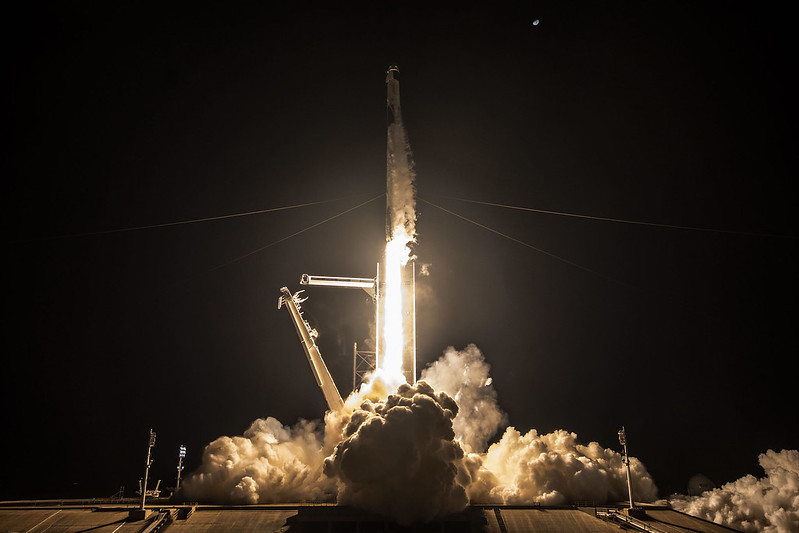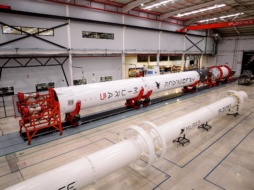Read Part 1 of this climate impact deep dive here.
Spaceflight can be a filthy business.
Each rocket that leaves the ground for an orbital destination drags behind it a trail of greenhouse gasses and particles of soot and alumina, depositing material into each layer of the delicately balanced atmosphere. And every satellite that reenters Earth’s atmosphere leaves traces of metals behind as it burns up.
For most of the history of spaceflight, these emissions weren’t such a big deal. The cadence of launch and satellite operations was low enough that whatever particles and gasses were left behind blended into the blurred, complicated background of emissions from everything else on the planet. Even today, rocket launches account for less than 0.01% of all CO2 emissions.
But as we stand at that famed inflection point in the history of spaceflight, the looming threat of irreversible climate change is beginning to rear its ugly head toward the potential impact of rocket launch and reentry on Earth’s atmosphere.
The big picture
To understand what’s unique about the space industry’s potential impact on climate, it’s important to understand the layers of the atmosphere and what they do…so here’s your two-minute climate science refresher:
- The troposphere is the layer of the atmosphere where we all live, and it’s where nearly all emissions come from.
- The stratosphere sits on top of the troposphere and houses the ozone layer, which protects us from UV radiation and other scary things. It has a fairly stable structure, and it’s inverted in temperature, colder lower down and warmer higher up.
- There’s a yearly cycle of material exchange between the troposphere and stratosphere. In the winter in either hemisphere, the stratosphere sits closer to the ground, and material flows downward.
- The mesosphere is above the stratosphere, and it’s where satellite reentry occurs.
- Above that is the thermosphere, where some LEO satellites orbit, and the exosphere, which is the outermost layer; it doesn’t have a clear boundary with outer space.
Spaceflight is often compared to aviation in terms of its emissions. Here, the difference in emissions and climate impact comes down to frequency: 100,000 airplanes take off around the world every day, while this year, there were ~2-3 rocket launches per week.
If the space industry’s ambitions are on the right track, though, that could change. Industry leaders envision a future where rockets are launching multiple times per day, and NOAA projects that a tenfold increase in spaceflight is likely in the next two decades—and that might even be on the lower end of what’s to come.
And orbital rocket launches provide another level of complexity over airplane emissions: they are the only human activity that injects emissions above the troposphere.
“There was this long-standing notion that the stratosphere was kind of unchanging and didn’t participate in climate change,” Daniel Cziczo, the Purdue department head of Earth, atmospheric, and planetary sciences, and author of a recent study on the impact of satellite reentry on the stratosphere, told Payload. “I think that’s starting to change.”
Burning up?
Satellite and other spacecraft reentry is changing the composition of the stratosphere—that much has been observed—and the consequences of that change are understood far less than those of greenhouse gas emissions like CO2, water, and chlorine.
Ten years ago, ~200T of satellites and rocket upper stages reentered the atmosphere each year, according to GAO estimates. That level now sits at something like ~800T per year according to Aerospace Corporation data. Martin Ross, a scientist studying commercial launch impacts at The Aerospace Corporation, estimated in an email to Payload that if, as projected by the GAO and other sources, there are ~60,000 satellites in LEO at any given time in about a decade, then ~16,000T of material, mostly satellites, will reenter the atmosphere each year.
It’s not fully understood what kind of an effect that level of reentry has on Earth’s climate, or what might happen if it increases to the magnitude expected in the coming years. One thing is for certain, though: when satellites “burn up” in the atmosphere as a method of disposal, they’re not just disappearing. Those metals remain part of Earth’s environment.
Meteoritic smoke: It’s not just spacecraft that fall victim to the corrosive effects of flying at high velocities through the upper atmosphere. When a meteorite falls to Earth, it “ablates,” i.e., gradually dissolves and burns up in the atmosphere, creating the signature fireball and leaving behind a distinctive residue atmospheric scientists call meteoritic smoke.
About 20 years ago, atmospheric scientists performed the first direct sampling of the stratosphere to suss out its chemical composition and identify evidence of this meteoritic smoke. These measurements lined up directly with the proportion of materials naturally occurring in meteorites.
“If we ground up a meteor in the lab, and then dissolved it in sulfuric acid and water, it looked exactly the same as what we were seeing in the stratosphere,” Cziczo said. “And so that gave us irrefutable proof that that was what was going on.”
Lately, though, things are changing.
“In the last few years we’ve gone back, and lo and behold, these particles that were in the stratosphere started to look a little bit different,” Cziczo said.
Suddenly, direct samples of the upper atmosphere included metals associated with spacecraft, which had not been there before in such high concentrations or at all. In a recent study, these metals included lithium, aluminum, copper, lead, magnesium, and sodium in ratios that align with spacecraft reentry. An estimated 10% of the aerosol particles in the stratosphere, which are responsible for protecting the ozone layer, contained aluminum.
On the up and up
When rockets launch, they emit a combination of gasses and particles, just like airplanes and other modes of transportation. But rockets emit an outsized proportion of material compared to airplanes, with rockets emitting ~200-300T of CO2 per launch. As of 2022, NOAA estimated that rockets emitted ~1,000T of black carbon into the atmosphere each year.
Comparing propellants: The emissions coming from launch depend heavily on the type of propellant used in a rocket.
- Kerosene-fueled rockets, like the workhorse Falcon 9 and Falcon Heavy, release soot—otherwise known as black carbon—as well as CO2 and water.
- Solid-fueled rockets emit chlorine gas, which is known to damage the ozone layer.
- Hydrogen-fueled rockets like NASA’s SLS produce water emissions, which still have a warming effect but are considered “cleaner” than other options because they don’t emit CO2.
- Methane is a popular fuel choice for the upcoming generation of heavy-lift rockets, including Starship, which is aiming, in the not-too-distant future, to represent a large proportion of launches. While methane itself is a powerful greenhouse gas, it breaks down mostly into water and CO2 upon combustion.
The effects of certain gasses on the atmosphere are fairly well understood. CO2 is a known greenhouse gas, remaining in the atmosphere for long periods of time regardless of the altitude at which it’s emitted. Even water deposited directly into the upper atmosphere has a known warming effect and can disrupt weather patterns. And chlorine, especially when deposited high off the ground like it is during rocket launch, disrupts the ozone layer.
It would take a remarkable increase in the cadence of rocket launch for the CO2 and water emissions from spaceflight to make a real dent in the global data, and truthfully, there are bigger offenders to tackle when it comes to meeting climate goals such as those set by the UN under the Paris Agreement. A bigger concern for spaceflight is in the particulate emissions, including black carbon and alumina, that can act as cooling agents, forming wide umbrellas in the upper levels of the atmosphere.
It’s not entirely cut-and-dry, though. We’re still lacking the robust data that would be needed to regulate or otherwise address emissions, or to know without a doubt how rocket emissions are affecting the atmosphere.
“Any comparison of the global impact of one rocket type to another is complicated by a lack of complete emissions data, insufficient models of the atmosphere, different efficiencies for putting payloads into orbit, and a lack of standard metrics on which to base comparisons,” Ross said in a recent interview. “The attention from scientists and policymakers needed to clearly define which propellant is more ‘green’ has not yet been done.”
Black carbon: It’s easier for scientists to measure rocket emissions down on Earth, where they’re most concentrated and easiest to reach. Black carbon—i.e., soot—emissions start at the source. When hydrocarbon rockets combust fuel, they release large amounts of soot into the atmosphere, which has known effects on climate and contributes to warming and disrupting stratospheric material flow patterns.
A NOAA-led study published last year modeled the climate impact from black carbon emissions at several different projected levels. The researchers looked at what might happen if the 1,000T of black carbon emitted by the rocket industry annually increased by an order of magnitude, which is likely over the next two decades according to industry targets, and found that the atmosphere is sensitive to these increases in black carbon, increasing stratospheric temperatures and leading to disruption of the ozone layer.
Another study from last year looked at the impact of the space industry’s projected black carbon emissions and found that the amount of carbon emitted by rockets at the altitudes modeled far outweighed the impact of other soot sources.
“The BC (or soot) particles from rockets are also of great concern, as these are almost five hundred times more efficient at warming the atmosphere than all other sources of soot combined,” the authors wrote.
Into the stratosphere: When rockets move up into orbit, they leave a trail of material behind them, which includes a combination of gasses and particulate matter. Higher up, there are two main environmental concerns associated with rocket trails:
- Chlorine gas emitted by solid-fueled rockets
- Particle emissions, including black carbon and alumina
Chlorine has been shown directly to create holes in the ozone layer, so it’s not a far leap to make that injecting chlorine into the stratosphere, where the ozone layer is, has detrimental effects. Chlorine emissions in the stratosphere are much more potent than emissions lower in the troposphere.
Particles, however, have a more mysterious effect. Though scientists know that black carbon in particular has a climate impact, the extent of that impact and the effect of other particle emissions from spaceflight is an area in need of more study.
“These particles accumulate in the stratosphere and form distinct, though invisible to the naked eye, layers according to their size and composition, absorbing and scattering sunlight before it reaches Earth’s surface causing climate forcing,” Ross said. “Because the sunlight intercept occurs high up in the stratosphere, the climate impacts are complex and difficult to understand.”
Looking ahead
The regulatory environment surrounding spaceflight is sparse (as covered in Part 1), and much of the reason for that is the lack of understanding about how space industry activities are affecting the atmosphere.
Long story short, there is an impact, but as with all atmospheric science, studies and findings are long delayed from when emissions are actually released into the atmosphere. And that effect is prolonged by the nature of spaceflight, which results in a proportionally greater impact higher in the atmosphere than other industries. It takes time for the effects to trickle down (literally).
Meanwhile, the space industry is growing incredibly rapidly. The demand for launch is increasing. The greater utilization of LEO means that frequent launches will be required in perpetuity to replenish low-hanging constellations, and rapidly developing space technology means that more launches will be required to replace aging and outdated satellites—while all of those old satellites create their own impact on their way back down to Earth.
More research into the long-term climate effects of launch and reentry, as well as more consideration by the industry to mitigate these potential impacts as demand and cadence increase, could be needed in order to keep the industry in line with climate goals for the coming decades.




